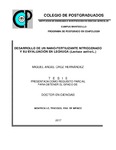| dc.description.abstract | En la presente investigación se sintetizaron nanopartículas de alginato cargadas con urea, evaluando su aplicación como nanofertilizante fuente de nitrógeno en cultivo hidropónico de lechuga (Lactuca sativa L.). La síntesis de las nanopartículas se realizó mediante la técnica de secado por aspersión a escala nano, empleando glutaraldehído como agente entrecruzante. Las partículas generadas fueron caracterizadas mediante las técnicas de microscopía electrónica de barrido (SEM), calorimetría diferencial de barrido (DSC), espectroscopia de infrarrojo con transformada de Fourier (FTIR) y potencial zeta. Además, pruebas de liberación de N se realizaron in vitro, con la finalidad de evaluar el comportamiento de las partículas como sistemas de liberación controlada. Los resultados mostraron la obtención de nanopartículas esféricas, con tamaños promedio de 650nm y carga superficial de -39 ±3 mV, la cual es un indicativo de buena estabilidad de las partículas al ser dispersadas en un medio acuoso. Por su parte, los estudios de EDS corroboraron la presencia y distribución homogénea de la urea (en forma de N) en la matriz polimérica, mientras que a través de FTIR y DSC, se comprobó el establecimiento de enlaces químicos entre alginato-alginato y alginato-urea producto de la incorporación de glutaraldehído. Las pruebas de liberación de nitrógeno indicaron que aproximadamente el 80% de la carga se liberó a las 72h de iniciado el experimento, por lo que se puede predecir que las partículas generadas pueden actuar como verdaderos sistemas de liberación controlada. En la segunda fase de la investigación se estableció un experimento con la finalidad de evaluar el efecto de las nanopartículas en parámetros de crecimiento, bioquímicos y nutrimentales en plantas de lechuga durante etapa vegetativa. Se establecieron 9 tratamientos los cuales se pueden agrupar en 3 grupos: a) tratamientos testigo, b) tratamientos con fertilizante convencional y c) tratamientos con nanofertilizante. El efecto de estos tratamientos fue evaluado en variables como longitud de hoja, longitud y volumen de raíz, numero de hojas y área foliar, biomasa fresca, biomasa seca, fenoles totales en hoja y concentraciones y acumulaciones nutrimentales. Al finalizar el experimento (13d), en parámetros de crecimiento como diámetro de tallo, número de hojas, área foliar y biomasa fresca y seca, en hoja y raíz, se observaron efectos positivos en tratamientos con nanofertilizantes, siendo estadísticamente diferentes a los otros tratamientos. Con respecto los parámetros bioquímicos, el contenido de clorofila se vio favorecido por la aplicación de nanofertilizante, mientras que en el contenido fenólico total hubo una disminución en los valores al aumentar la concentración de N en todos los tratamientos donde dicho elemento estuvo presente. Finalmente, en relación a concentración y acumulación de macronutrimentos en vástago se lograron observar mayores valores de N en tratamientos con nanofertilizante, mientras que para P, K, Ca y Mg se observaron efectos contrarios o sin diferencias entre tratamientos. Con respecto a la raíz, la concentración y acumulación de N y Ca fue significativamente mayor en tratamientos con nanofertilizante. A pesar del corto tiempo del experimento, los resultados obtenidos en esta investigación son prometedores y crean una posibilidad real de que los materiales sintetizados puedan ser potencialmente utilizados como nanofertilizantes. _______________ DEVELOPMENT OF A NITROGENOUS NANO-FERTILIZER AND ITS EVALUATION IN LETTUCE. ABSTRACT: In the present research work, alginate nanoparticles loaded with urea were synthesized to evaluate their application as a nanofertilizer to supply nitrogen in hydroponically grown lettuce (Lactuca sativa L.). The synthesis of the nanoparticles was done through spray drying at a nano scale using glutaraldehyde as cross linking agent. The generated particles were characterized through scanning electron microscopy (SEM), differential scanning calorimetry (DSC), Fourier-transform infrared spectroscopy (FTIR), and zeta potential. Also, N liberation tests were done in vitro in order to evaluate the behavior of the particles as controlled liberation systems. The results showed the obtainment of spherical nanoparticles, mean size 650 nm, and surface charge of -39 ± 3 mV, which indicates good stability of the particles when being dispersed in an aqueous medium. Meanwhile, the EDS studies corroborated the homogeneous presence and distribution of urea (as N) in the polymer matrix, and through FTIR and DSC, the chemical links between alginate-alginate and alginate-urea, product of the incorporation of glutaraldehyde, were proven. The nitrogen liberation tests indicated that approximately 80% of the load was released 72 h after the beginning of the experiment. Thus, we can predict that the generated particles can act as true controlled liberation systems. In the second stage of the research, an experiment was set up in order to evaluate the effect of the nanoparticles on growth, biochemical, and nutrient parameters of lettuce plants during their vegetative stage. Nine treatments were established, grouped into three groups: a) control treatments, b) conventional fertilizer treatments, and c) nanofertilizer treatments. The effect of these treatments was evaluated in variables like leaf length, root length and volume, number of leaves and leaf area, fresh biomass, dry biomass, total phenols in the leaves, and nutrient concentrations and accumulations. At the end of the experiment (13 d), positive effects were observed in the treatments with nanofertilizers in growth parameters like number of leaves, leaf area, and fresh and dry biomass of leaves and roots, all of them being statistically different from the other treatments. With regard to the biochemical parameters, chlorophyll content was favored by the application of the nanofertilizer, while there was a decrease in the the total phenol values as the N concentration increased in all the treatments where the element was present. Finally, with regard to macronutrient concentration and accumulation in the shoot, there were greater N values in the treatments with nanofertilizer, while in the case of P, K, Ca, and Mg, contrasting effects were observed, with no differences between treatments. With respect to the roots, the concentration and accumulations of N and Ca were significantly higher in the treatments with nanofertilizer. Despite the short run-time of the experiment, the results obtained in the present research work are promising and create a real possibility that the synthesized materials can be potentially used as agricultural nanofertilizers. | es_MX |


